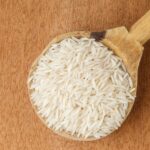
Macedonian Juniper with High Volatile Oil
October 26, 2024
1121 Double Steamed Basmati Rice, the Top-Notch Basmati Variety
October 26, 2024Dry roses are a versatile functional food, rich in antioxidants and beneficial for gut health. Nutralfa Ltd. supplies high-quality dry rose petals in bulk, in palletized shipments as well as in container load be it 20’ or 40’. These dry roses are food grade acceptable by EU & USFDA and are widely used in tea, jams, supplements and cosmetic industries.
Large Scale Rose Farms

The cultivation of red roses in Pakistan occurs across numerous farmlands, particularly in the Sindh province, where regional yields can range from 2,500 to 2,800 kg per hectare. Red roses flourish in expansive farms across the Sindh province of Pakistan, thriving throughout the year except when temperatures drop below 10°C. These farms utilize nutrient-rich soil and are irrigated by lake waters from the northern Himalayan foothills, ensuring a consistent supply of high-quality roses.
Raw Material Cultivation Environment
The cultivation environment for roses is enriched by the unique combination of fertile soil. The roses benefit from the natural irrigation provided by streams flowing from the foothills of the Himalayas, creating an ideal setting for growth.
Rose Harvesting Process
Harvesting occurs year-round, with daily collections during the sunny seasons, primarily in spring and summer when the blossoms are at their peak. The flowers are carefully gathered to preserve their freshness, ensuring only the best roses are selected for drying and processing.
Seasonal Factors
While roses can be harvested at any time of year, spring and summer yield the best results. Seasonal variations can affect growth and yield, prompting careful management of the plants to optimize production throughout the year.
Methods of Drying & Selection as per HACCP Protocols
Dry rose petals are selected from healthy, contaminant-free roses and naturally dried using methods such as air drying. After drying, the petals are inspected for defects and contaminants before being packaged in designated bags. Throughout the process, cleanliness and hygiene are maintained to prevent cross-contamination, with proper storage in cool, dry areas to preserve quality and flavor. By adhering to HACCP protocols, we minimize potential hazards such as microbial contamination, chemical residues, and physical contaminants like foreign objects, ensuring that the dried rose petals are safe for food, tea, and cosmetic applications. Moisture content and weight of petals:
The drying process maintains a specific moisture content to ensure the petals remain lightweight and aromatic. This is crucial for quality, as it impacts the final product’s usability and appeal.
⦁ Conducting analysis of pesticides:
To ensure the safety and quality of our ingredients, rigorous testing is conducted on each batch of dried rose petals. This includes assessing for impurities and ensuring that only the highest quality petals are supplied to customers. When the sample is supplied to our clients, they conduct pesticide analysis at their end.
⦁ Rosa gallica vs Rosa chinensis:
Rosa gallica and Rosa chinensis share many similarities in their uses and applications. Rosa gallica is known for its deep pink to red flowers, prized for their strong fragrance and vibrant color, making it ideal for use in perfumery, skincare, teas, and culinary products. On the other hand, Rosa chinensis blooms in a variety of colors, including pink, red, and white, with a delicate structure but similar aromatic qualities. Both species are commonly used in tea, cosmetics, and natural remedies, offering mild, sweet flavors and pleasant scents that enhance a wide range of products. Whether used in culinary dishes, herbal infusions, or beauty formulations, both Rosa gallica and Rosa chinensis provide versatile and effective results, making them interchangeable for many purposes while delivering consistent quality.

⦁ How roses are known in other languages:
French: Pétales de Rose Séchés, Spanish: Petalos De Rosa Secos, Italian: Petali di Rosa Essiccati, German: Getrocknete Rosenblätter, Urdu/Hindi: Gulab, Turkish: Gul
Usage
⦁ Rose petals consumed as food globally:
Rose petals are widely used in various culinary applications, including tea, jams, and beverages, adding a delightful floral flavor and aroma to dishes.
⦁ Natural plant-based health supplements:
Rich in antioxidants and vitamins, rose petals serve as natural health supplements that support gut health and overall well-being.
⦁ Use for medicinal purposes and traditional remedies:
Rose petals are commonly employed in traditional medicine to treat skin conditions such as acne, eczema, and skin irritation. They are also valued in dermatology and aesthetics for promoting a healthy, radiant complexion often referred to as “glass skin.”

Our brand ‘Starlit’ rose hydrosol mist instantly rejuvenates the skin. It is an intensive hydrating toner and is nourishing, soothing, and anti-inflammatory. It is 100% steam distilled from fresh red rose flower petals.
Supply of High-Quality Rose Petals in Bulk
With hundreds of farms dedicated to rose production, our company ensures a steady supply of high-quality premium rose petals in bulk. This abundant production capacity allows us to meet the growing demand for rose petals in various applications, from functional food uses to traditional remedies. Our commitment to quality ensures that our customers receive premium petals suitable for diverse needs.
For inquiries on dry rose, please write to info@nutralfa.uk




